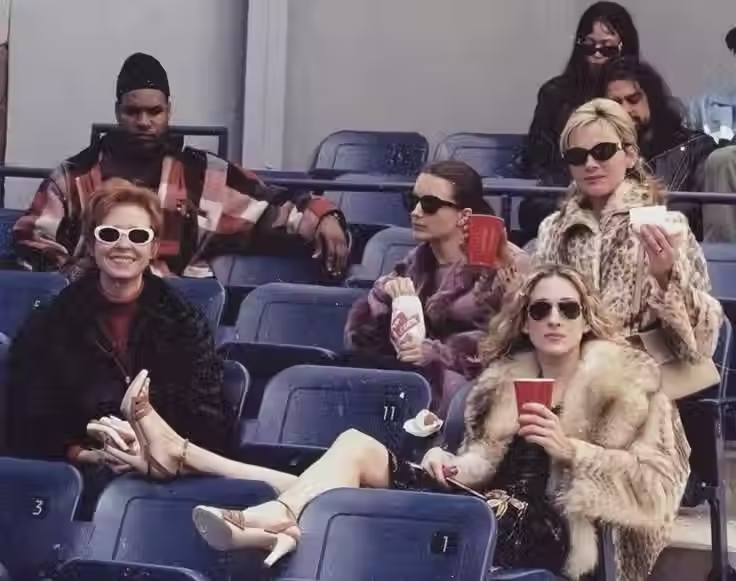Life After Brain Rot: Why Micro Trends Have Become a Low Status Behavior
- Juliette Murer
- Feb 19
- 3 min read
How Algorithms Cooked Our Personal Style
Fashion has always been cyclical, but in the past few years, it’s felt like we were running a hamster wheel of trend fatigue, and now, the wheel has finally snapped. Microtrends, once the driving force behind viral fashion moments, are dying a very public death. Not just because they’re exhausting to keep up with, but because wearing them has become a low-status behavior.
Let’s be honest: fashion lost the plot somewhere between the return of the peplum and the bubble skirt revival. Trends were no longer dictated by subcultures, designers, or even consumer demand, they were manufactured, mass-produced, and shoved down our throats by algorithms designed to reward the most extreme aesthetics. The result? A landscape where clothes weren’t being designed for people, but for engagement.
Who exactly was asking for the return of the coquette bolero? Or the fleeting obsession with Regencycore? These weren’t trends, they were costumes. What we wore stopped being about personal style and became pure simulacrum, an aesthetic language that only really existed online.
For a while, it worked. Microtrends fed into the dopamine-fueled fast fashion cycle, where everyone could buy into the latest thing and be onto the next thing before their order even shipped. But eventually, the cracks started to show. The irony of the trend cycle accelerating to breakneck speeds is that people stopped caring. The sheer volume of microtrends (think “balletcore,” “mob wife,” “blokette,” “tomato girl,” “frazzled English woman,” and whatever else TikTok has dreamed up this week) diluted their impact.
By 2024, dressing in microtrends stopped being aspirational and became embarrassing.

Dressing in Microtrends is Now a Low-Status Behavior
Fashion is a status game. It always has been. And now, dressing like a walking Pinterest board of last month’s aesthetics signals the exact opposite of good taste.
Why? Because it tells the world you are chronically online.
The people who are actually shaping fashion, the ones whose style is referenced, not recycled, aren’t the ones panic-buying the latest trending silhouette from Zara. They’re the ones who have stepped back from the cycle entirely, favoring longevity, authenticity, and IRL wearability over the next viral moment.
The pivot away from microtrends isn’t just happening in fashion—it’s visible across design industries. In architecture and interiors, there’s a rejection of cold, museum-like minimalism in favor of spaces that look lived in. Luxury firms are now photographing homes with messy countertops, scattered children’s toys, and imperfect lighting—a stark contrast to the austere, clinical interiors of the 2010s that felt more like mausoleums than homes.
The shift is clear: real life is the new luxury.

Welcome to the Post-Brain Rot Era: The Return of Personal Style
If the past five years were defined by overconsumption and aesthetic ADHD, the next five years will be defined by refinement, POV, and IRL relevance.
We’re already seeing the pendulum swing away from trend-chasing and toward capsule dressing, investment pieces, and personal uniformity. “Quiet luxury” wasn’t just about stealth wealth, it was a symptom of this larger shift. Now, even maximalists are refining their approach. The point isn’t minimalism for minimalism’s sake; it’s about dressing with intention.
This is why brands that lack a strong, definable point of view are struggling. Consumers no longer want to buy from brands that make them feel like they’re dressing for the algorithm instead of themselves. The appeal of fashion in 2025 isn’t about fitting into a trend category, it’s about transcending trends entirely.
What This Means for Fashion Moving Forward
Brands Need to Understand That “Chronically Online” is Not Aspirational
The era of designing for TikTok virality is ending. Consumers are actively rejecting brands that feel trend-chasing, desperate, or too obviously trying to manufacture engagement.
The brands that are succeeding are the ones that feel anchored in something deeper, whether that’s heritage, craftsmanship, or a strong design identity.
IRL Will Become the Ultimate Status Symbol
Just as home design is embracing messy realism, personal style is moving toward practicality with personality, clothing that works outside of a social media post.
The idea of being “effortlessly stylish” has become the new flex. If your entire wardrobe only makes sense in a trend compilation video, you’ve already lost.
The New Luxury is a Definable POV
The only “trend” that will matter moving forward is having a perspective. It’s not about dressing quiet or loud, minimal or maximal, it’s about dressing in a way that feels like you.
Brands that embrace this and create pieces with lasting value (rather than trend-chasing) will win.
The future of fashion won’t be dictated by whatever TikTok’s latest microtrend is—it will be dictated by those who refuse to participate in the churn.
The microtrend era is over. The post-brain rot era has begun.




Comments